Research Article - (2025) Volume 15, Issue 3
The study of biological, density and sex ratio of snails Neritina violacea, (Gmelin, 1791) in Shatt Al-Aarb, Basrah, Iraq
Intisar Mohammed Ali Jabbar*, Mohammed Faris Abbas and Ibtsam Mahdi Abdul-SahibAbstract
Between October 2021 to September 2022, snail samples, specifically Neritina violacea, were collect seasonally from two selected sites in the Shatt al-Arab. At the first station, Garmat Ali and the second station, Salhiya, environmental factors such as temperature, salinity, pH and dissolved oxygen levels in the water The measurements were taken.
This study analyzes the population structure of Neritina violacea snails in the intertidal zone of the Shatt al-Arab River, focusing on density, sex ratio, length and body weight. The snail density was 67.7 and 71.6 individuals per square meter, with a sex ratio ranging from 0.47:1 to 0.616:1 (female: male) and an average length of 20.91 mm. Canonical correlation analysis indicated a positive correlation between snail density and dissolved oxygen, while an inverse correlation was found with salinity, temperature and pH values at both study sites.
Keywords
Density, Neritina violacea, Sex ratio, Shatt Al-Arab, Iraq.
Introduction
Freshwater snails are among the most common invertebrates and play a significant role in ecosystems by feeding on algae and dead organic matter, while also serving as a food source for various organisms (Kwong KL, et al., 2010 and Karim RM. (2022).
The Neritidae family is found globally, primarily in tropical and subtropical regions, although some notable species also inhabit temperate oceans. In addition to marine and estuarine environments, they can be found in freshwater habitats in tropical areas. They are among the most prevalent intertidal mollusks along tropical and subtropical coastlines (Jabbar AMA, et al., 2021).
Most species of Nerita inhabit rocky shores and coral reefs, where they often endure the sun's heat or seek shelter in crevices, under rocks, or among seaweed. These snails are typically active when wet or during the rising and falling tides. Their diet primarily consists of algae that grow on rock surfaces (Frey MA, 2010). In estuarine environments, species of Nerita and Neritina can be found on rocks, wood and mangrove roots, where they may be either herbivorous or carnivorous, feeding on organisms such as fly larvae (Liline S, et al., 2020).
Species inhabiting exposed rocky shores have thick shells that help them resist desiccation and defend against predators. There is a diversity in shell shape among certain populations and tropical species may display a wide range of colors (Echem RT, 2017).
In this family, there is a clear separation between the sexes and fertilization occurs internally. The male has a penis located on the right side of his head, which is use to transfer sperm to the female (Frey MA, 2008).
While most snails are hermaphroditic, possessing both male and female reproductive organs, some species exhibit distinct sexual classifications as male or female. Sexual dimorphism in heterosexual mollusks can be identifi through differences in shell shape, external appearance and body size (Yusa Y, 2007 and Collin R, 2013). On the other hand, hermaphrodites do not typically present external morphological differences indicating sex. Body size is a characteristic of the entire organism and cannot be solely attribut to sexual function, although there tends to be a positive correlation with egg production (Nakadera Y and Koene JM, 2013). Furthermore, body size can vary with age (Nakadera Y, et al., 2015). This tricky issue needs to be investigated further, but it is necessary to mention that certain characteristics can be phenotypically plastic mechanisms that adapt to various other environmental novelties to which sex allocation has nothing to do with them (Schärer L, 2009; Nakadera Y and Koene JM, 2013 and Janicke T and Chapuis E, 2016).
Numerous studies have examined the Neritidae family in freshwater environments (e.g., Flores-Garza R, et al., 2012 and Al-Baghdadi NM, et al., 2024).
The objective of the current research is to study population structure and to concentrate on specific observations of the snail Neritina violacea density, sex ratio, size and body weight in the intertidal zone of the Shatt al-Arab River as there is no previous biological research done about this particular species in the region.
Materials and Methods
Sampling sites
Collection of seasonal samples was carried out since October 2021 to September 2022 in two given sites in the Shatt al-Arab. The first station, Garmat Ali, is located at coordinates 30°34'11.62" N, 47°45'08.84" E. The structure of this station is a beach that is sloping 5 meter long, the coast has remnants of rocks and stones. Sea waves and boats of different sizes move around the area in search of fish and only a few numbers of plants are affected.
The second station, Salhiya, is situated in the Shatt al-Arab district at coordinates 30°30'42.11" N, 47°51'18.60" E. This location is characterizing by a dense growth of aquatic plants and numerous obstacles on the beach, such as submersible jetties, which create semi-protected areas from water currents resembling swamps. These conditions create a suitable environment for certain plants. However, this area also suffers from pollution caused by organic pollutants from domestic and agricultural sewage. Additionally, it faces challenges related to grazing and overharvesting due to the high population in the region. The movement of small and medium-sized boats for fishing and transport operations along the banks of the Shatt al-Arab is common. Moreover, traces of oil can be observing on plants near the water, likely resulting from the washing of boats (Fig. 1). Seasonal samples were collected from two selected sites in the Shatt al-Arab between October 2021 and September 2022. The first station, Garmat Ali, is located at coordinates 30°34′11.62″ N, 47°45′08.84″ E. This station features a sloping beach of approximately 5 meters and a coastline scattered with rocks and stones. Only a few plants are affect by sea waves and various sizes of boats navigate the area in search of fish.
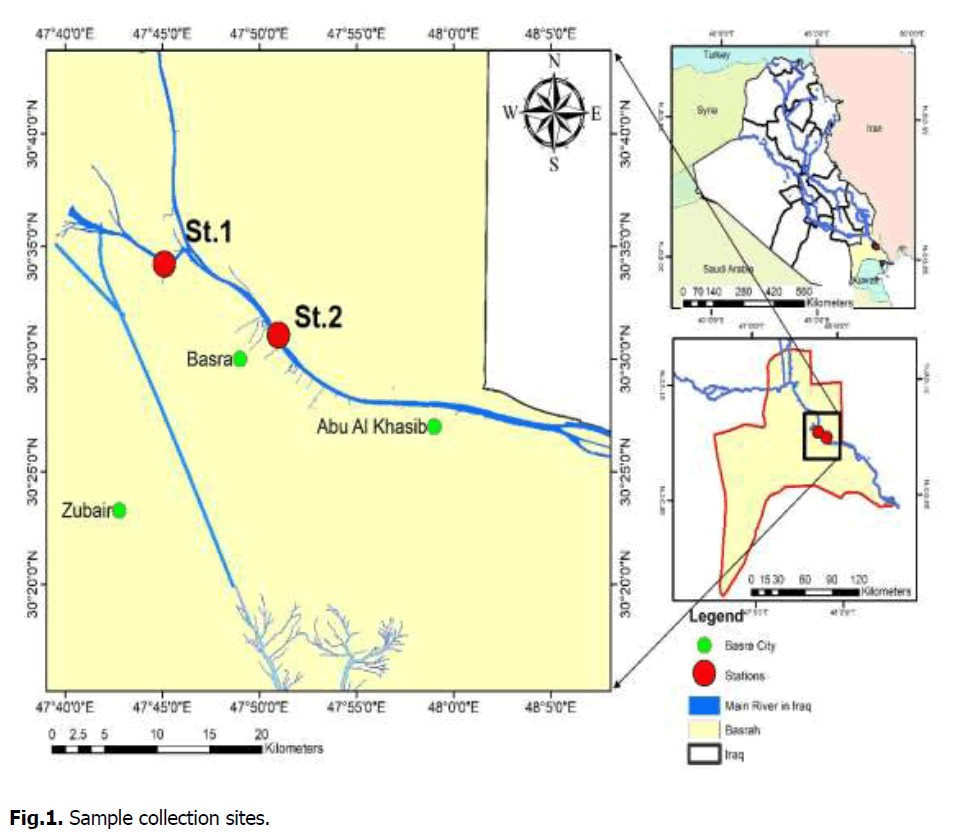
Fig. 1. Sample collection sites.
The second station, Salhiya, located in the Shatt al-Arab district, is at coordinates 30°30′42.11″ N, 47°51′18.60″ E. This site is characterized by a dense population of aquatic plants and many obstacles on the beach, such as submerged dubs, creating semi-protected areas from water currents that resemble swamps. These conditions foster a suitable environment for certain plant species. However, this area is also exposing to pollution from organic waste originating from domestic and agricultural runoff. Additionally, due to its proximity to populated areas, it faces challenges such as grazing and overharvesting. The region is frequented by small and medium-sized boats engaged in fishing and transportation along the banks of the Shatt al-Arab. Furthermore, signs of oil accumulation on plants near the water have been observed, likely a result of boat washing activities (Fig. 1).
Environmental measurements
In this study, environmental measurements were taken monthly during each collection. Water temperature was measured in the field at the time of sample collection using a thermometer that measures temperatures from 0 to 100 °C. Dissolved oxygen levels were assessed according to Rice EW, (2012). Additionally, Salinity concentration and pH were measured in the field using a YSI Model 57 device, manufactured by Kalbuneh Company, USA.
Sampling methods
Seasonal samples of Snails were collect quarterly from each station by hand and kept in nylon bags. The belt transect method was used for sampling in environmental studies of snails, utilizing the quadrat method (Richards PW, 1976 and Jabbar AMA, 2013), which is the most common and appropriate technique for intertidal zone areas.
The samples were bringing to the laboratory, where population density was calculated and the snails were separate by gender into individual bottles. In the laboratory, the snails were categorizing and preserved in separate bottles containing 4% formalin.
Biological indices and statistical analysis
Snail weights were measure using a sensitive scale of Chinese origin, while their lengths were measure with a ruler and caliper. The relationships between weight and length for each sex were represented by the formula: Y=a x b (Zar JH, 1999 and Jabbar AMA, 2021).
The density of the snail population was calculated monthly by dividing the total number of collected snail individuals by the total area sampled (snails/m²). This was determined using the total number of individuals collected from all sampling units, divided by the total area sampled at all stations during the sampling period.
The sex ratio was established by taking the total number of collected females and dividing it by the total number of males, resulting in a female to male (F:M) ratio (Flores-Garza R, et al., 2012).
Results
In Garmat Ali station, phenotypic measurements were taken for male and female individuals of the snail Neritina violacea. The length of males ranged from 11.2 to 32.9 mm, while the length of females ranged from 9.74 to 26.71 mm. Statistical analysis revealed a positive significant correlation between the lengths of males and females across different seasons, with correlation coefficients of r=0.943 for males and r=0.523 for females (Fig. 2). The weight of males varied between 0.294 and 6.67 g, whereas the weight of females ranged from 0.91 to 4.33 g. The analysis indicated a favorable significant correlation between the weights of males and females and the different seasons, with correlation coefficients of r=0.941 for males and r=0.484 for females (Fig. 3).
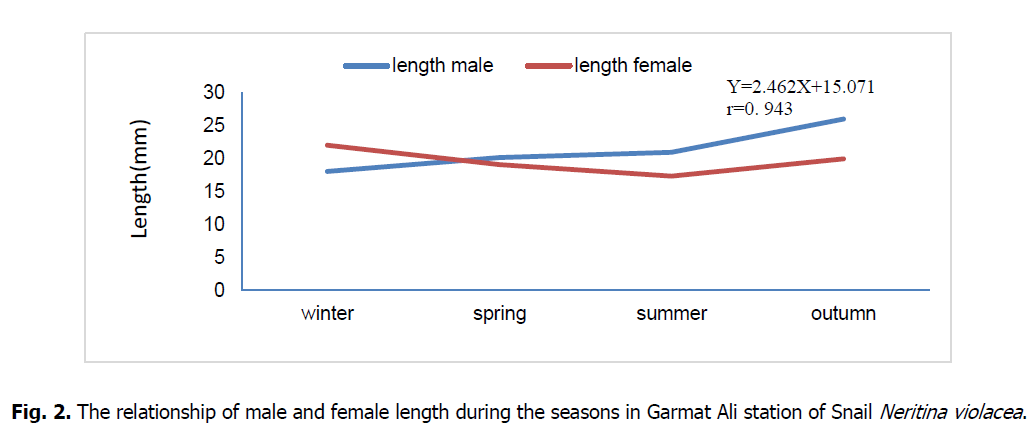
Fig. 2. The relationship of male and female length during the seasons in Garmat Ali station of Snail Neritina violacea.
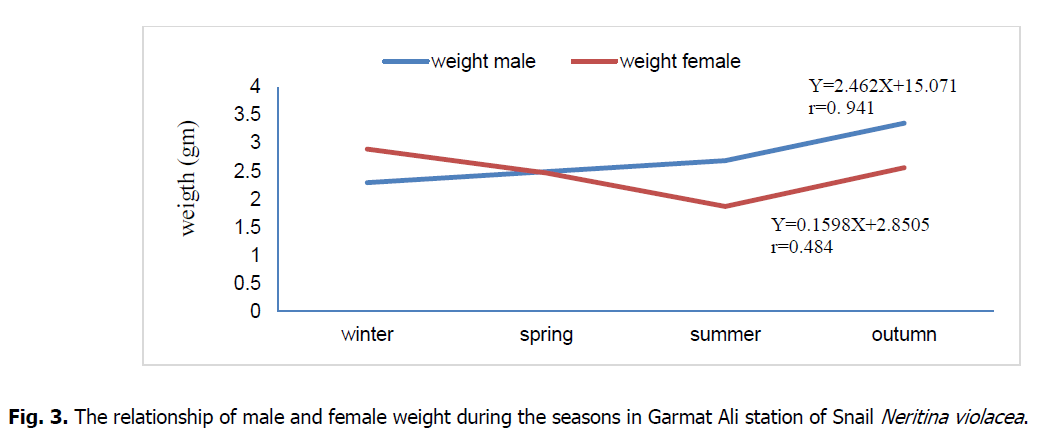
Fig. 3. The relationship of male and female weight during the seasons in Garmat Ali station of Snail Neritina violacea.
Fig. 4 shows the results of a multiple statistical analysis of Neritina violacea at Garmat Ali station. A positive significant correlation was find between snail density and dissolved oxygen levels. Conversely, a strong inverse significant correlation was observing between snail density and salinity. Additionally, an inverse correlation was note between species density and temperature, which was more pronounce than the correlation with pH values.
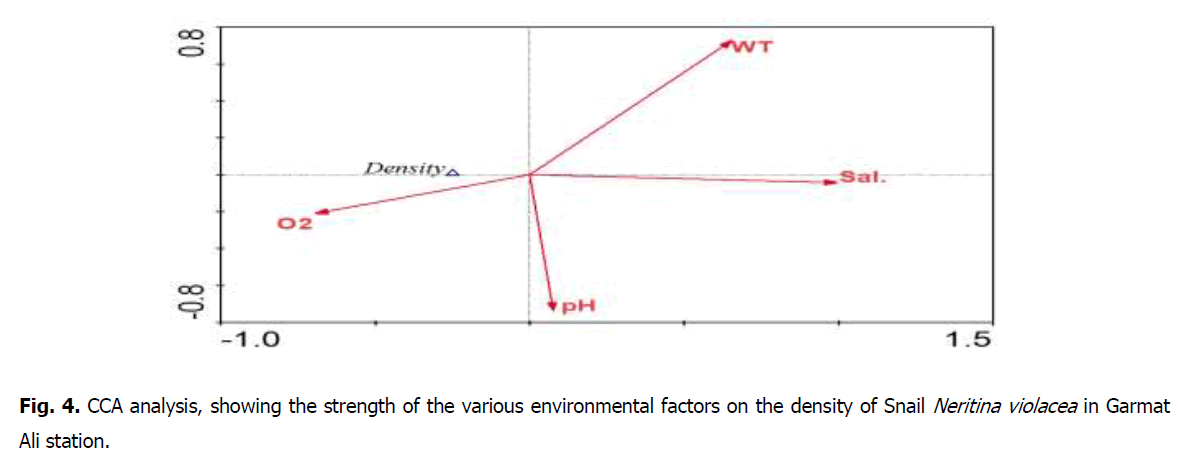
Fig. 4. CCA analysis, showing the strength of the various environmental factors on the density of Snail Neritina violacea in Garmat Ali station.
At Salhiya station, the measurements of male and female individuals showed that their lengths ranged from 6.74 to 25 mm for males and 9.62 to 31.93 mm for females. The statistical analysis indicated a positive significant correlation between the lengths of males and females and the different seasons, with correlation coefficients of r=0.817 for males and r=0.542 for females (Fig. 5). The weights of males ranged from 0.294 to 5.315 g, while females ranged from 1.02 to 4.82 g. The analysis showed a favorable significant correlation between the weights of males and females and the different seasons, with correlation coefficients of r=0.845 for males and r=0.548 for females (Fig. 6).
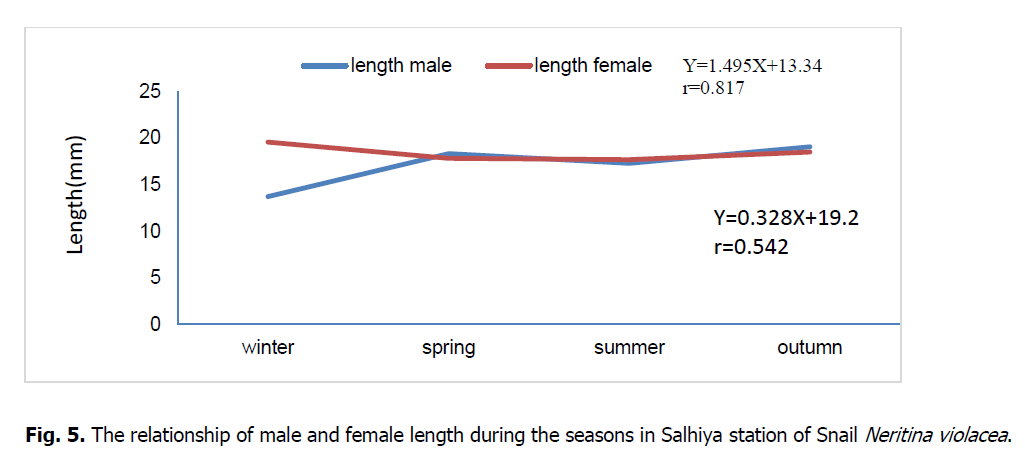
Fig. 5. The relationship of male and female length during the seasons in Salhiya station of Snail Neritina violacea.
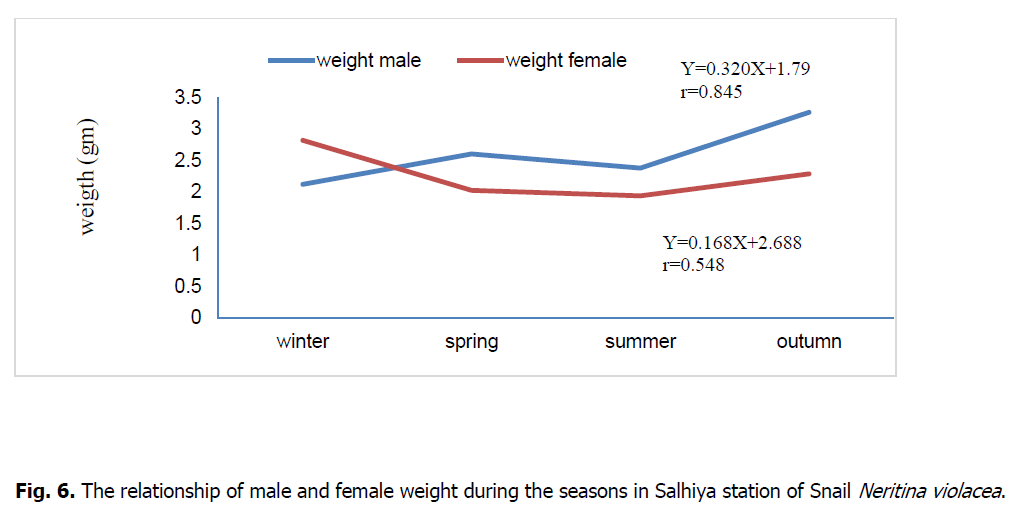
Fig. 6. The relationship of male and female weight during the seasons in Salhiya station of Snail Neritina violacea.
Fig. 7 shows a strong positive correlation between the density of the snail Neritina violacea and dissolved oxygen levels at the Salhiya station, with this correlation being more pronounced than that observed at the first station. In contrast, at the second station, there is an inverse correlation between the density of this species and salinity, although this relationship is weaker compared to what was noted at the first station. Also at the second station, inversed correlations are recorded between the density of the species and temperature as well as the pH degree.
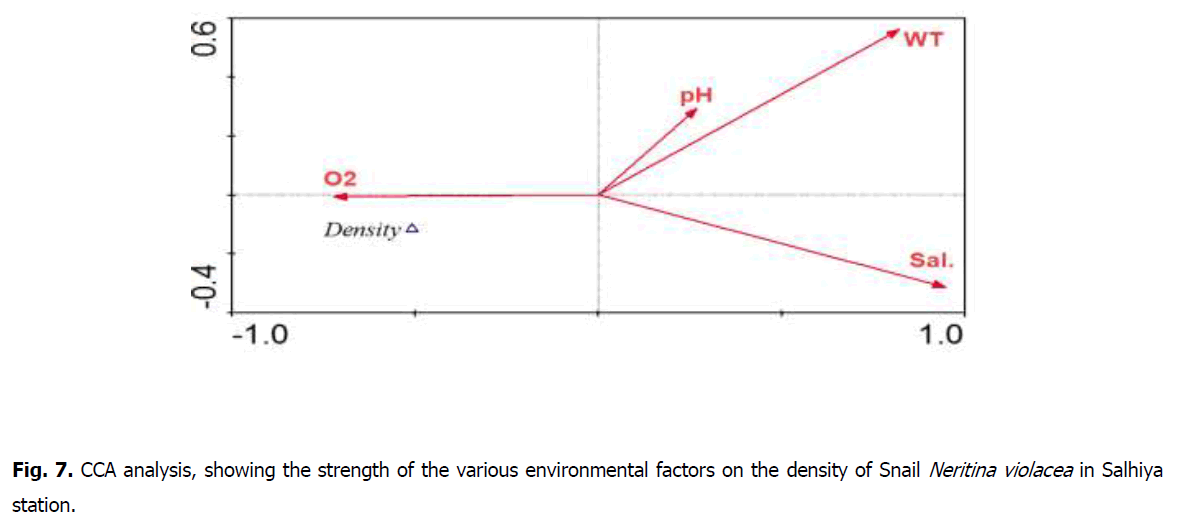
Fig. 7. CCA analysis, showing the strength of the various environmental factors on the density of Snail Neritina violacea in Salhiya station.
In Tables 1 and 2, total of 1,162 specimens of the snail Neritina violacea were analyzed, which included 746 females and 416 males from both study sites. The estimated density across all sampled areas ranged from 67.7 to 71.6 individuals per square meter for both sexes. The lowest density was observe in spring, with only 12.2 individuals per square meter, comprising 5.2 males and 7 females. In contrast, the highest density was record in autumn at the Garmat Ali station, reaching 9.6 males and 11.2 females. During winter, the lowest density at the Salhiya station was 11.6 individuals per square meter, which included 7.6 females and 4.0 males.
| Date | Gender | No. | Density | Sex Ratio |
|---|---|---|---|---|
| All | Both | 457 | 67.7 | 0.47:1 |
| Male | 310 | 6.6 | ||
| Female | 147 | 61.1 | ||
| Winter | Both | 113 | 18.2 | 01:02.2 |
| Male | 35 | 6.6 | ||
| Female | 78 | 11.6 | ||
| Spring | Both | 105 | 12.2 | 0.361 |
| Male | 77 | 5.2 | ||
| Female | 28 | 7 | ||
| Summer | Both | 105 | 18.1 | 01:01.8 |
| Male | 38 | 6.7 | ||
| Female | 67 | 11.4 | ||
| Autumn | Both | 134 | 20.8 | 0.522:1 |
| Male | 88 | 9.6 | ||
| Female | 46 | 11.2 |
Table 1. Total of analyzed specimens, density (individuals/m2), sex ratio (F:M) and numbers, in sampling dates for Snail Neritina violacea in Garmat Ali station.
| Date | Gender | No. | Density | Sex Ratio |
|---|---|---|---|---|
| All | Both | 705 | 71.6 | 0.616:1 |
| Male | 436 | 29.2 | ||
| Female | 269 | 42.4 | ||
| Winter | Both | 148 | 11.6 | 1.85:1 |
| Male | 52 | 4 | ||
| Female | 96 | 7.6 | ||
| Spring | Both | 179 | 17.8 | 0.754:1 |
| Male | 102 | 8.4 | ||
| Female | 77 | 9.4 | ||
| Summer | Both | 176 | 24 | 01:02.0 |
| Male | 58 | 7.8 | ||
| Female | 118 | 16.2 | ||
| Autumn | Both | 202 | 18.2 | 0.683:1 |
| Male | 120 | 9 | ||
| Female | 82 | 9.2 |
Table 2. Total of analyzed specimens, density (individuals/m2), sex ratio (F:M) and numbers, in sampling dates for Snail Neritina violacea in Salhiya station.
Summer had the highest density of 24.0 individuals per square meter with a male/female ratio of 7.8 and 16.2 respectively. The resulting sex ratio, using the total number of all the tested snails provided, at Garmat Ali station was a ratio of 0.47:1 female per male. The ratio of sex ranged between 0.36:1 during spring and 1:2.23 in winter. The sex ratio based on the number of snails that were tested at the Salhiya station is 0.616: 1 which is a female per male. The ratio during autumn was 0.683:1 and during summer 1:2.03.
Discussion
The association between the weight and the height is paramount in the management of water bodies, aquaculture as well as evaluation of water body fauna. Learning how to measure length and width of lines is essential since it also established the available size of the stock as well as showing the type of growth neither symmetrical nor asymmetrical (Zheng Y, et al., 2022). The findings of the investigation revealed that, at the Garmat Ali station, the total length of specimens varied from 9.74 mm to 32.9 mm; at the Salhiya station, the same range applied for both sexes. These ranges surpass the average lengths recorded by Yunus and Samsi (2021), which for men and women in the demographic age groups in the Tongke-Tongke village, Sinjai Regency, South Sulawesi, ranged between 5 mm and 25 mm.
According to Samsi AN and Karim S. (2019), the common length of the snail Nerita lineata, found in mangroves, ranges from 22.27 mm to 25.57 mm, with typical weights between 4.93 grams and 6.09 grams. This variation in size is believed to be influence by environmental quality factors such as temperature, salinity, pH and food availability (Abdul-Sahib IM and Khalaf TA, 2006).
Statistical analysis revealed a significant correlation between the total length and total weight of males compared to females across various seasons at both stations. This difference can be attribut to restricted growth in females, as their reproductive activities require a distribution of food energy between growth and egg production (Mendo T, et al., 2016).
The sex ratio is a key factor in determining reproductive strategy, as it reflects how a species responds to environmental changes (Székely T. 2023). Unlike some other snails, nerites are not hermaphroditic. Although identifying the gender of nerite snails can be challenging, paying close attention to size, shell shape and color can aid in determining their gender (Cabuga CC. 2017).
While monosexual organisms ideally have a sex ratio of 1:1, this ratio may shift in favor of one sex depending on the area and time of year (Deekae SN and Abowei JFN, 2010). This study recorded a male-dominant sex ratio, which aligns with findings by Acevedo et al. (1996), who documented male dominance over females when analyzing sex ratios in different regions along Mexican beaches, also recorded density of 4.83 snails/m². The sex ratio ranged from 0.76:1.00 to 1.00:0.96 (F:M), with an average size of 20.91 mm. In females, the best-represented sizes were from 10.5 mm to 28.5 mm, while for males, it was from 13.5 mm to 28.5 mm. The average weight recorded was 1.99 g. Yoshida K, et al., (2022) noted that the sex ratio of the snail Laguncula pulchella at Matsukawaura Lagoon, Japan, varied with seasons but was significantly biased towards males during the main copulation period in summer. This trend can be link to sex-biased predation risks, which may alter the growth and production of prey under environmental pressures.
The highest density of the snail was record during the summer at both stations, likely due to the direct effect of temperature on the efficiency of aquatic organisms, combined with the rapid growth of phytoplankton that provides food for these organisms (Al-Aboudi HR, 2009), The current study's results align with previous reports on the Shatt al-Arab (Abdul Rasoul RM, 2019; Ahmed RAV, 2015).
Fig. (4-7) illustrate the relationship between environmental factors and the density of the snail Neritina violacea at both stations. Most environmental factors showed an inverse correlation with density; in particular, dissolved oxygen was one of the environmental factors most closely associated with density. This finding is consistent with Al-Baghdadi NM, et al. (2023), who found a positive relationship between dissolved oxygen and the density of Melanoides tuberculata in the tidal zone of the Shatt al-Arab, along with an inverse relationship with salinity. Similarly, Khalaf RZ, (2011) found a positive correlation between M. tuberculata density and pH in the Shatt al-Arab and some southern marshes. However, the current study's results contradict those of Al-Maliky AM, et al. (2022), who reported a negative correlation between the density of two gastropod species, Melanoides tuberculata and Melanopsis praemorsa, from the Euphrates River - Basrah, Iraq. Their study indicated a negative correlation between density and various temperature levels, particularly during the summer, while pH did not affect density.
Conclusion
The current study showed the existence of seasonal and localized changes in the average densities Quantitative population at selected stations, which indicates that environmental factors are controlling. The presence and density of the snail. In general, the study recorded seasonal differences in the sex ratio, noting through the results the predominance of the total sex ratio for males over females.
Acknowledgement
The researchers thank the Marine Biology Department at the Marine Science Center - University of Basra for providing all facilities to complete this article.
Ethical Statement
I must believe in and adhere to my personal beliefs. Examples of ethical principles like, integrity, honesty, good conduct, justice, compassion in dealing with others, mutual respect, self-respect, honesty in dealing with others and avoiding infringement on the rights of others.
Data Availability
All available publication data are presented in the article.
Informed Consent Statement
All research participants consented.
Authors Contribution
The first researcher wrote the scientific paper and obtained the samples, while the second researcher conducted statistical analysis and third researcher translated and edited the language. All authors critically reviewed the manuscript and agreed to submit the final version of the manuscript.
Conflict of Interest
We, the authors of the publication, declare no conflict of interest.
References
Kwong, K. L., Dudgeon, D., Wong, P. K., Qiu, J. W. (2010). Secondary production and diet of an invasive snail in freshwater wetlands: Implications for resource utilization and competition. Biological Invasions 12:1153-1164.
Google Scholar, Cross Ref, Indexed at
Karim, R. M. (2022). Evaluation of DNA damage of cadmium in gastropod Lymnaea radix cor (Annandale and Prashad, 1919) from Euphrates river. Research Journal of Pharmacy and Technology 15:2761-2764.
Google Scholar, Cross Ref, Indexed at
Jabbar, A.M. A., Najem, S. M., Sultan, E. N. (2021). Some phenotypic characteristics of the Hepu mitten crab, Eriocheir hepuensisDai, 1991 (Grapsoidea: Brachyura), from Shatt Al-Arab. Iraqi Journal of Aquacult 18:77-86.
Frey, M. A. (2010). The relative importance of geography and ecology in species diversification: Evidence from a tropical marine intertidal snail (Nerita). Journal of Biogeography 37:1515-1528.
Google Scholar, Cross Ref, Indexed at
Liline, S., Kubangun, M. T., Kurnia, T. S., Heremba, W. N. M. J. (2020). Density of Nerita sp in Negeri Suli Coastal Waters, Baguala Bay, Central Maluku Regency. (Biology Science and Education): Science and Education Research Journal 9:109-114.
Google Scholar, Cross Ref, Indexed at
Echem, R. T. (2017). Morphometric relations of gastropod species: Nerita albicilla and Patella nigra. World News of Natural Sciences 7.
Frey, M. A. (2010). A revised classification of the gastropod genus Nerita. Veliger 51:1.
Yusa, Y. (2007). Causes of variation in sex ratio and modes of sex determination in the Mollusca-an overview. American Malacological Bulletin 23:89-98.
Google Scholar, Cross Ref, Indexed at
Collin, R. (2013). Phylogenetic patterns and phenotypic plasticity of molluscan sexual systems. Integrative and Comparative Biology 53:723-735.
Google Scholar, Cross Ref, Indexed at
Nakadera, Y., Koene, J. M. (2013). Reproductive strategies in hermaphroditic gastropods: conceptual and empirical approaches. Canadian Journal of Zoology 91:367-381.
Google Scholar, Cross Ref, Indexed at
Nakadera, Y., Swart, E. M., Maas, J. P., Montagne-Wajer, K., Ter Maat, A., Koene, J. M. (2015). Effects of age, size and mating history on sex role decision of a simultaneous hermaphrodite. Behavioral Ecology 26:232-241.
Google Scholar, Cross Ref, Indexed at
Schärer, L. (2009). Tests of sex allocation theory in simultaneously hermaphroditic animals. Evolution 63:1377-1405.
Google Scholar, Cross Ref, Indexed at
Janicke, T., Chapuis, E. (2016). Condition dependence of male and female reproductive success: Insights from a simultaneous hermaphrodite. Ecology and Evolution 6:830-841.
Google Scholar, Cross Ref, Indexed at
Flores-Garza, R., González, A. V., Flores-Rodríguez, P., Cruz-Ramirez, N. L. (2012). Density, sex ratio, size, weight, and recruitment of Plicopurpura pansa (Gastropoda: Muricidae) in Costa Chica, Guerrero, Mexico. Open Journal of Marine Science 2:157.
Google Scholar, Cross Ref, Indexed at
Al-Baghdadi, N. M., Mohammed F. Abbas, Ghassan A. Al-Najare, Kadhim H. Younis, Rafid M. Karim. (2024). Monitoring environmental changes in the Shatt al-Arab river using the Organic Pollution Index (OPI) and two species of benthic invertebrates Melanoides tuberculataandNeritina violacea. Egyptian Journal of Aquatic Biology & Fisheries Zoology 28:889 – 909.
Rice, E. W., Baird, R. B., Eaton, A. D., Clesceri, L. S. (2012). Standard methods for the examination of water and wastewater.
Richards, P. W., Willis, A. J. (1976). Introduction to plant ecology: A guide for beginners in the study of plant communities. Journal of Ecology 64:391.
Jabbar, A.M. A. (2013). Ecological assessment of Shatt Al-Arab River by adopting Indices of water quality and biological integrity. Collage of Agriculture – Basrah University 106.
Zar, J. H. (1999). Biostatistical analysis. Pearson Education India.
Zheng, Y., Shi, Y., Li, S., Deng, W., Zhou, J., Hu, B., Zhou, Y. (2022). Environmental determinants for snail density in Dongting Lake region: An ecological study incorporating spatial regression. The American Journal of Tropical Medicine and Hygiene 107:1178.
Google Scholar, Cross Ref, Indexed at
Samsi, A. N., Karim, S. (2019). The relationship between the length and weight of snail Nerita lineata Gmelin 1791 on environmental factors in the mangrove ecosystem. In Journal of Physics: Conference Series Vol. 1341:022022.
Google Scholar, Cross Ref, Indexed at
Abdul-Sahib, I. M. and Khalaf, T. A. (2009). The finer characters of some Snail’s shells (Mollusca:Gastropoda) from Shatt Al-Arab region. Journal of Basrah Researches (Sciences) 32: 97–104.
Mendo, T., Semmens, J. M., Lyle, J. M., Tracey, S. R., Moltschaniwskyj, N. (2016). Reproductive strategies and energy sources fuelling reproductive growth in a protracted spawner. Marine Biology 163:1-11.
Google Scholar, Cross Ref, Indexed at
Székely, T. (2023). Evolution of reproductive strategies: Sex roles, sex ratios and phylogenies. Biologia Futura 74:351-357.
Google Scholar, Cross Ref, Indexed at
Cabuga, C. C. (2017). Describing shell shape variations and sexual dimorphism of golden apple snail, Pomacea caniculata (Lamarck, 1822) using geometric morphometric analysis. Computational Ecology and Software 7:123.
Deekae, S. N., Abowei, J. F. N. (2010). Macrobrachium macrobrachion (Herklots, 1851) class structure and sex ratio in Luubara creek, Ogoni land, Niger Delta, Nigeria.
Yoshida, K., Setogawa, T., Sato, T., Yamada, M., Sato, T., Narita, K., Tomiyama, T. (2022). Male-biased sex ratio in the crawling individuals of an invasive naticid snail during summer: Implications for population management. Scientific Reports 12:7911.
Google Scholar, Cross Ref, Indexed at
Al-Aboudi, H. R. (2009). An environmental study of some types of snails in Al-Diwaniyah Governorate (Doctoral dissertation, Al-Qadisiyah University 101.
Abdul Rasoul, R. M. (2019). Environmental assessment of the water quality of the Shatt al-Arab at the center of Basrah city, Doctoral dissertation, University of Basrah 152.
Ahmed, R. A. Z. (2015). Evaluation of organic pollution level and its effect on diversity of the filamentous algae and fishes infected with copepods from three stations in Basrah province, Iraq, Doctoral dissertation, University of Basrah 139.
Al-Baghdadi, N. M., Sultan, E. N., Abdullah, A. A. M. (2023). Effect of some environmental factors on the presence and density of the snail Melanoides tuberculata (Müller, 1774) in the tidal region of Shatt Al-Arab, Iraq Basrah. Iraqi Journal of Aquaculture 20:41-60.
Google Scholar, Cross Ref, Indexed at
Khalaf, R. Z. (2011). An environmental study of gastropods from the tidal zone in Shatt al-Arab-Iraq, Doctoral dissertation, University of Basrah 94.
Al-Maliky, A. M., Al-Maliky, T. H., Al-Khafaji, K. K. (2022). Ecological study of two gastropods species Melanoides turbuculata and Melanopsis preaemorsa from Euphrates river-Basrah, Iraq. Journal of Applied and Natural Science 14:1119.
Google Scholar, Cross Ref, Indexed at
Acevedo, J. M. A. Escalante and M. Turok. The Purple Snail. In: A. Sanchez, F. Dilio, C. Fuentes and S. García-Real. (1996). Relevant Fisheries of Mexico. Secretariat of the Environment, Natural Resources and Fisheries, Mexico 1100.
Mustapha, N., Baharuddin, N., Tan, S. K., Marshall, D. J. (2021). The neritid snails of Brunei Darussalam: Their geographical, ecological and conservation significance. Ecologica Montenegrina 42:45-61.
Google Scholar, Cross Ref, Indexed at
Kliman, R. M. (2016). Encyclopedia of evolutionary biology. Academic Press.
Yunus, M., Samsi, A. N. (2021, February). Morphometric Variations of Nerita Lineata Gmelin 1791 in Different Mangrove Age Groups in the Ecosystem. In Journal of Physics: Conference Series 1752:012052.
Google Scholar, Cross Ref, Indexed at
Author Info
Intisar Mohammed Ali Jabbar*, Mohammed Faris Abbas and Ibtsam Mahdi Abdul-SahibCitation: Jabbar, IMA., Abbas, MF., Abdul-Sahib, IM. (2025). The study of biological, density and sex ratio of snails Neritina violacea, (Gmelin, 1791) in Shatt Al-Aarb, Basrah, Iraq. Ukrainian Journal of Ecology. 15:12-22
Received: 03-May-2025, Manuscript No. UJE-25-165472; , Pre QC No. P-165472; Editor assigned: 05-May-2025, Pre QC No. P-165472; Reviewed: 19-May-2025, QC No. Q-165472; Revised: 24-May-2025, Manuscript No. R-165472; Published: 31-May-2025, DOI: 10.15421/2025_613
Copyright: This is an open access article distributed under the terms of the Creative Commons Attribution License, which permits unrestricted use, distribution, and reproduction in any medium, provided the original work is properly cited.
